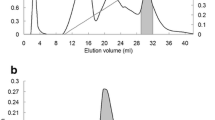Abstract
Although several investigators have presented data suggesting that the Caprifoliaceae is polyphyletic in origin, the family has been retained as a taxon in recent classifications. Serological analyses of the taxa included within the family have been undertaken to provide additional taxonomic data. Precipitin techniques of double diffusion (Ouchterlony) and nephelometry (Boyden Procedure) were used to analyse serological similarities of seed proteins from representatives of the family. Three distinct groupings were detected for the taxa included in the Caprifoliaceae. AlthoughViburnum exhibited greatest serological similarity withSambucus, Viburnum was quite distinct from all members of the family investigated.Sambucus also was somewhat distinct from the other genera and exhibited about as much serological correspondence withCornus of the Cornaceae as with any tested member of the Caprifoliaceae. The remaining species examined formed a very close serological grouping. These data can be interpreted as supporting either a monophyletic or polyphyletic origin of the family as presently composed, because of the different arrangements of the families Caprifoliaceae and Cornaceae in the various systems of classification.
Similar content being viewed by others
Literature Cited
Alston, R. E. &B. L. Turner 1963. Biochemical Systematics. Englewood Cliffs, New Jersey: Prentice-Hall, xii + 404 pp.
Boyden, A. 1967. The place of precipitin testing among newer trends in taxonomy. Bull. Nat. Inst. Sci. India34: 108–117.
Cronquist, A. 1965. The status of the general system of classification of flowering plants. Ann. Missouri Bot. Gard.52: 281–303.
— 1968. The Evolution and Classification of Flowering Plants. Boston: Houghton Mifflin Co. x + 396 pp.
DeVos, F. 1951. The stem anatomy of some species of the Caprifoliaceae with reference to the phylogeny and identification of the species. Thesis: Ph.D. Cornell Univ. 81 pp.
Fairbrothers, D. E. 1966. Comparative serological studies in plant systematics. Bull. Serological Museum (New Brunswick)35: 2–6.
— 1968. Chemosystematics with emphasis on systematic serology. pp. 141–174.In: V. H. Heywood (Editor), Modern Methods in Plant Taxonomy. London & New York: Academic Press, 312 pp.
— 1969. Plant serotaxonomic (serosystematic) literature, 1951–1968. Bull. Serological Museum (New Brunswick)41: 1–11.
— &M. A. Johnson 1964. Comparative serological studies within the families Cornaceae (dogwood) and Nyssaceae (sour gum), pp. 305–318.In: C. A. Leone (Editor), Taxonomic Biochemistry and Serology. New York: The Ronald Press Co. x + 728 pp.
Ferguson, I. K. 1966a. The genera of Caprifoliaceae in the Southeastern United States. Jour. Arnold Arb.47: 33–59.
— 1966b. The Cornaceae in the Southeastern United States. Jour. Arnold Arb.47: 106–116.
Hawkes, J. G. (Editor) 1968. Chemotaxonomy and Serotaxonomy. (Systematic Association Special Volume, No. 2). London & New York: Academic Press. 299 pp.
Hillebrand, G. R. 1966. Phytoserological systematic investigation of the genusViburnum. Thesis: Ph.D. Rutgers Univ. 77 pp.
— &D. E. Fairbrothers 1969. A serological investigation of intrageneric relationships inViburnum (Caprifoliaceae). Bull. Torrey Bot. Club96: 556–567.
Hock, F. 1892. Zur systematischen Stellung vonSambucus. Bot. Centralbl.51: 233, 234.
Hunziker, J. H. 1969. Molecular data in plant systematics. pp. 280–312.In: Systematic Biology: Proc. International Conference in 1967. Washington, D.C.: Nat. Acad. Sci. Publ. 1692.
Hutchinson, J. 1948. British Flowering Plants. Evolution and Classification of Families and Genera, with Notes on their Distribution. London: P. R. Gawthorn Ltd. viii + 374 pp.
— 1967. The Genera of Flowering Plants. Dicotyledons. Vol. II. Oxford, England: Clarendon Press. xi + 659 pp. (Caprifoliaceae, pp. 81–89.)
Johnson, M. A. &D. E. Fairbrothers 1965. Comparison and interpretation of serological data in the Magnoliaceae. Bot. Gaz.126: 260–269.
Killip, E. P. &A. C. Smith 1930. The South American species ofViburnum. Bull. Torrey Club57: 245–258.
Melchior, H. 1964. Umbelliflorae. pp. 367–379.In: H. Melchior (Editor), A. Engler’s Syllabus der Pflanzenfamilien. Vol. 2. Angiospermen. Berlin: Gebrüder Borntraeger. 666 pp.
Ouchterlony, ö. 1964. Gel-diffusion techniques, pp. 55–78.In: J. F. Ackroyd (Editor), Immunological Methods. A symposium organized by the Council for International Organizations of Medical Sciences, established under the joint auspices of UNESCO and WHO. Philadelphia, Pennsylvania: F. A. Davis Co. xvi + 628 pp.
Rehder, A.. 1949. Bibliography of Cultivated Trees and Shrubs Hardy in the Cooler Temperate Regions of the Northern Hemisphere. Jamaica Plain, Massachusetts: Arnold Arboretum of Harvard Univ. xl + 825 pp.
Sax, K. &D. A. Kribs 1930. Chromosomes and phylogeny in Caprifoliaceae. Jour. Arnold Arb.11: 147–153.
Vaughan, J. G. 1968. Serology and other protein separation methods in studies of angiosperm taxonomy. Sci. Progr. (Oxford)56(222): 205–222.
Wagenitz, G. 1964a. Gentianales. pp. 405–424.In: H. Melchior (Editor), A. Engler’s Syllabus der Pflanzenfamilien. Vol. 2. Angiospermen. Berlin: Gebrüder Borntraeger. 666 pp.
— 1964b. Dipsacales. pp. 472–478.In: H. Melchior (Editor), A. Engler’s Syllabus der Pflanzenfamilien. Vol. 2. Angiospermen. Berlin: Gebrüder Borntraeger. 666 pp.
Wilkinson, Antoinette M. 1948a. Floral anatomy and morphology of some species of the tribe Lonicereae of the Caprifoliaceae. Amer. Jour. Bot.35: 261–271.
— 1948b. Floral anatomy and morphology of some species of the tribes Linnaeeae and Sambuceae of the Caprifoliaceae. Amer. Jour. Bot.35: 365–371.
— 1948c. Floral anatomy and morphology of some species of the genusViburnum of the Caprifoliaceae. Amer. Jour. Bot.35: 455–465.
— 1949. Floral anatomy and morphology ofTriosteum and of the Caprifoliaceae in general. Amer. Jour. Bot.36: 481–489.
Author information
Authors and Affiliations
Additional information
Financial aid from National Science Foundation Grants GB-1217 and GB-3847
Rights and permissions
About this article
Cite this article
Hillebrand, G.R., Fairbrothers, D.E. Phytoserological systematic survey of the caprifoliaceae. Brittonia 22, 125–133 (1970). https://doi.org/10.2307/2805806
Issue Date:
DOI: https://doi.org/10.2307/2805806




